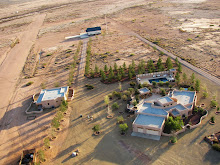Lake Cloverdale sits at the base of Animas valley and extends into Mexico. Covering an area of about 102 km2 (27 square miles), Lake Cloverdale is now only a grassy field with scattered cattle tanks. The shoreline of this shallow pluvial lake is clearly visible in the photographs and based on the elevation change the lake was no more than 10-20 feet deep at the margin. Several stream beds from the surrounding mountains, including Cloverdale Creek were part of the lake’s recharge system as well as springs like Cienega Springs which brought ground water into the lake. It now sits abandoned by the water as the climate dried after the last ice age and is now the largest grass landing field I can think of, although it sits on the 320,000 acre Diamond A Ranch (still known locally as the Grey Ranch).
Click to enlarge photographs

Looking south down Animas valley along the drainage toward Lake Cloverdale.

Looking southwest from the north shore of Lake Cloverdale across the former lake.

View from the south looking north at the former shoreline of Lake Cloverdale.

Looking north at the shoreline, showing the boat ramp on Lake Cloverdale.








No comments:
Post a Comment